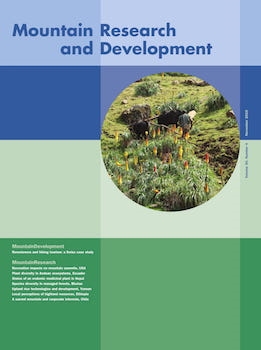The Caucasus: An Introduction by Frederik Coene. London, UK: Routledge, 2010. xvi + 238 pp. US$ 130.00. ISBN 0-415-48660-6.
Readers who expect a book on mountain issues in the Caucasus will be disappointed by this volume. The fact that most of the Caucasian region is within mountain areas plays a minor role in the argumentation of the author, who is a political science scholar for international organizations. However, it was not his intention to provide details of mountain geography. The book developed from his recognition that no recent textbook covers a region that is of ever-increasing interest in regional and global politics. If you do not find a book that is adequate for your work, you have to write it yourself—and this is what Coene has done. The result is a remarkable introduction to a region which—because of its former inclusion in the Soviet Union—has been neglected for a long time.
Coene presents his text in 8 chapters of different length and weight. He starts with a glimpse of the geography in which he considers many facts but cannot provide an in-depth analysis: 26 pages are not sufficient for more than an encyclopedic overview. Territorial division, government, and administration form chapters of similar length.
Population and society form the third basic topic required to describe the current situation; the main focus of this chapter is on history and the manifold conflicts. Nearly all regional and ethno-political conflicts, mostly unsolved, are considered in depth, from their outbreak in the final months of the Soviet Union to the present situation. This chapter is the most sophisticated part of the book, reflecting the author's main interest. As he is one of the actors in the international organizations that intend to mediate these conflicts, the book continues with an overview on international politics that focus on the Caucasian region.
The 2 remaining chapters, dealing with economy and culture, are relatively short and weak in argumentation. With regard to economy, this can be understood because the statistical basis for all deliberation and explanation is extremely poor. The statistical offices of the 3 post-Soviet successor states in the South Caucasus still do not provide current data of the appropriate amount and detail. The chapter on culture and traditions mentions different aspects, but does not integrate them into a holistic analysis of the region. However, this is not the main goal of the book, which is addressed to students and scholars in social and political sciences who wish to have a survey on the Caucasus.
Overall, description prevails and argumentative interpretation is in the background. Yet it must be acknowledged that Coene does not omit topics such as physical geography, hydrology, climate, main landscape types, ecosystems, and biodiversity. He argues that there is a certain relationship (though not a dependency) between the natural background and the historical developments and recent political issues. In the chapter on physical geography, he does not intend to follow geodeterministic argumentations as it is not his main interest. This chapter is one of the most descriptive, enumerating important facts and omitting others, and does not develop an impression of the interrelationships between the physical background and human activities.
Another criticism concerns the character of a textbook for students and scholars. Coene does not reflect scientific discourses concerning the region; he lists a number of scientific works, mainly in English and Russian, but does not meet the needs of a student who is looking for the basic texts and in-depth study of any topic. Developing such a volume would require a significant effort, but Coene wanted—and this should not be considered a negative—a brief introduction for students and scholars to one of the most critical regions of the world.
Open access article: please credit the authors and the full source.





